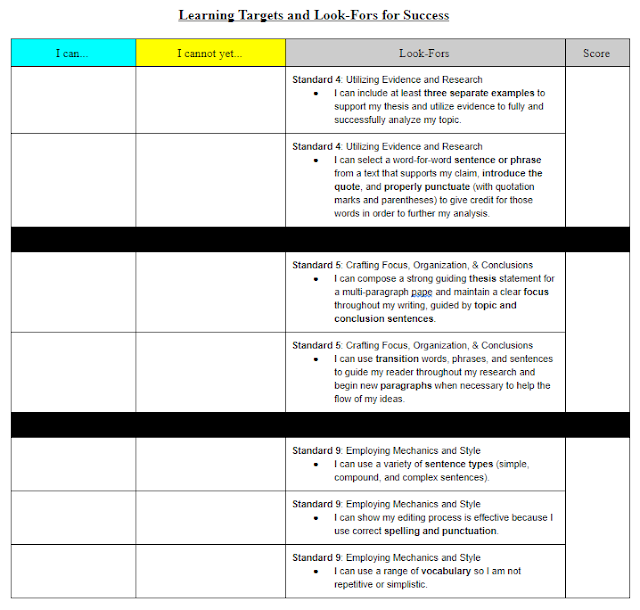Assessing by Standards in the Secondary ELA Classroom
Back in September, I
blogged about “Constructing Standards-Based Rubrics in the Secondary ELA
Classroom.” I traced my
assessment journey across three stages:
- Analytic Rubric
- Holistic Rubric
- Standards-Based Scoring Rubric
Back in January 2019, I
shifted my rubric yet again. With a clearer focus of my standards, by that time (and after having taught for
another full Fall semester), I knew I needed another shift. I liked scoring on
an A, B, C, and F (as bands of grades rather than raw scores or percentages)
but differentiating between each level was getting challenging and cumbersome.
I turned more fully to Jennifer Gonzalez’s (@cultofpedagogy) post “Holistic, Analytic, and Single-Point Rubrics.” More in line with Gonzalez’s listing of
success criteria (which also fits with learning targets), my current rubrics
focus on what we are asking students to do. Then, I make a professional
judgment call on whether it is an A, B, C, or F.
THE RUBRIC:
I CAN/CANNOT YET:
Rather than create a
checklist of grammar concepts that I included in my former holistic rubric, I have left space for me to type comments. Sometimes I just
leave an X in one of the two columns. My general rule is an X or comment in the
“I can” column suggests an A or a B, where a check or
comment/suggestion/reminder in the “I cannot yet” column suggests a C or F.
Ideally, I would
eventually like to film instructional videos (inspired by Andre Easton’s—@EastonA1—2017 NCTE session) of the
concepts we teach so we can link those to the “I cannot yet” column for
students to review (as we encourage students to revise work).While this rubric
may not offer so many specific details students should address, that is reserved
more for conferences during workshop. Rather than leave so many grammar edits (I am
no longer a copy-editor!) or lengthy notes, I can now discuss those with
students as they work (or revise). Thus, this rubric allows me to more directly
assess.
LOOK-FORS:
This column lists what
students should know and be able to do. These are rather consistent each time
they appear on a rubric. And, these rubrics are located directly in the Google
Docs that students receive to type their work in. I need to do a better job at
centering these rubrics for every assignment to draw student attention to them,
but their inclusion and consistency is a huge step forward for me (see
“Communicating Standards to Students” near the middle of this blog-post). I am still uncertain if each assignment is asking for too much
(the rubric above is for a larger research piece, but even a paragraph-length
analysis will assess three standards). I appreciate subdividing each standard
by one, two, or three learning targets and look-fors, but I am still working on
the appropriate number for each assignment. Students have responded favorably to knowing how they score in each standard, so some students have
begun utilizing the different categories: I need to assist the other students
to this reflection.
SCORE:
In the score category, I type an A, B, C, or F and color-code that cell (blue for A, green for B, yellow for C, and red for F). I normally reserve an F for a failure to demonstrate learning (which could mean missing). I know a score for no work is arguably not a strong choice on my end, but students can always revise, and sometimes seeing the F notifies them that they did not submit an assignment. I do not have a hard-and-fast rule for what each letter grade truly means (which we see in the 1-4 proficiency scoring: what is a 4?). I usually work within the following guidelines:
In the score category, I type an A, B, C, or F and color-code that cell (blue for A, green for B, yellow for C, and red for F). I normally reserve an F for a failure to demonstrate learning (which could mean missing). I know a score for no work is arguably not a strong choice on my end, but students can always revise, and sometimes seeing the F notifies them that they did not submit an assignment. I do not have a hard-and-fast rule for what each letter grade truly means (which we see in the 1-4 proficiency scoring: what is a 4?). I usually work within the following guidelines:
- A: The work meets the look-fors and demonstrates a strong practice of the standard.
- B: The work meet the look-fors and the student has demonstrated understanding (and allows for some errors).
- C: The work is approaching proficiency with some demonstration or attempt at the standard. However, the student’s work fails to successfully meet the look-fors.
- F: The work is missing or incomplete. Perhaps there is not enough work to confirm proficiency of the look-fors.
There is subjectivity
here, but perhaps no more than the arbitrariness of any grading scale. I have not have students claim that our
scoring is unfair. Through conferencing during workshops, students and I can
clarify confusions and address stumbling blocks.
CONCLUSIONS (FOR NOW):
I will be continuing
with this rubric formatting moving into next school year. I like the division
by standard (and it will be categorized in the gradebook as such—one score for
each standard), as well as the breakdown of one, two, or three look-fors per
standard.
This rubric (with some
of its subjectivity) further shows the interconnectedness of curriculum,
instruction, and assessment. The assessment scoring tool is derived from the
standards of the curriculum, and the instruction within a workshop model allows
for a more direct assessment process (rather than leaving lines and lines of
written feedback that students may ignore). The integration of curriculum,
instruction, and assessment here is empowering for me as an educator—it
provides a sense that I am on the right track!




Comments
Post a Comment